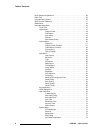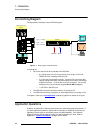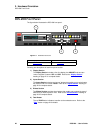
14 DCS-200 • User’s Guide
NK==fåíêçÇìÅíáçå
How to Use This Guide
eçï=íç=rëÉ=qÜáë=dìáÇÉ
This section provides important tips for streamlining your use of this User’s Guide in its
electronic “PDF” form.
k~îáÖ~íáåÖ
Use Acrobat Reader’s “bookmarks” to navigate to the desired location. All chapter files
have the same bookmark structure for instant navigation to any section. Please note:
• Extensive hyperlinks are provided within the chapters.
• Use Acrobat’s “Go to Previous View” and “Return to Next View” buttons to trace
your complete navigational path.
• Use the “Previous Page” and “Next Page” buttons to go to the previous or next
page within a file.
• Use Acrobat’s extensive search capabilities, such as the “Find” tool and “Search
Index” tool to perform comprehensive searches as required.
q~ÄäÉ=çÑ=`çåíÉåíë=~åÇ=fåÇÉñ
Use the Table of Contents bookmarks to navigate a desired topic. Click any item to
instantly jump to that section of the guide. You can also use the Index to jump to specific
topics within a chapter. Each page number in the Index is a hyperlink.
`çåîÉåíáçåë=
The following conventions are used throughout this guide:
• The symbol denotes an operations procedure.
• The symbol S denotes an example.
• Entries written in bold-face capital letters denote physical buttons or chassis
connectors.
S Press LOGO to ...
• The term “select” is used as an abbreviation for “scroll to a selected menu line
and press the SEL button.”
• A sequence of menu steps is represented by the menu names, separated by
arrows (>).
S INPUT > Timing Adjust > H Position
... indicates the following sequence:
a. From the Main Menu, select INPUT to display the Input Menu.
b. Scroll to the Timing Adjust line and press SEL to display the Timing
Adjust Menu.
c. Scroll to the H Position line and press SEL to adjust the image’s
horizontal position.


















